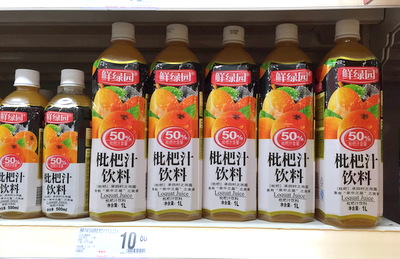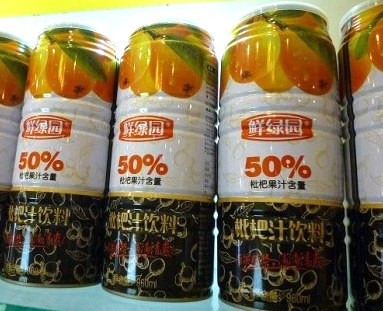Loquat Fan, who contributed this article to NextInsight, highlights how Garden Fresh, which already has an 86% share of the loquat juice market in China, is further sharpening its competitive edge.
 94% of Garden Fresh beverages sold in 2015 were packaged in pet bottles. File photo.THERE ARE TWO salient features about the beverages sold by Sino Grandness' subsidiary, Garden Fresh:
94% of Garden Fresh beverages sold in 2015 were packaged in pet bottles. File photo.THERE ARE TWO salient features about the beverages sold by Sino Grandness' subsidiary, Garden Fresh:
First, they are retailed predominantly (94%) in pet bottles and,
Second, they are mainly (54%) produced by contract manufacturers.
The actual figures for 2015 are as follows and are taken from page 221 of the "application proof" (or draft prospectus) that Garden Fresh submitted in its bid for a listing on the Hong Kong Stock Exchange. (Click here)
 94% of Garden Fresh beverages sold in 2015 were packaged in pet bottles. File photo.THERE ARE TWO salient features about the beverages sold by Sino Grandness' subsidiary, Garden Fresh:
94% of Garden Fresh beverages sold in 2015 were packaged in pet bottles. File photo.THERE ARE TWO salient features about the beverages sold by Sino Grandness' subsidiary, Garden Fresh: First, they are retailed predominantly (94%) in pet bottles and,
Second, they are mainly (54%) produced by contract manufacturers.
The actual figures for 2015 are as follows and are taken from page 221 of the "application proof" (or draft prospectus) that Garden Fresh submitted in its bid for a listing on the Hong Kong Stock Exchange. (Click here)
| Table A: 2015 sales revenue (RMB m) | |||
| Type of packaging | Self-produced | Outsourced | Total |
| Pet bottle | 1,061 | 1,115 | 2,176 (94%) |
| Flip-top can | n/a | 111 | 111 (5%) |
| Tetra pak | n/a | 32 | 32 (1%) |
| Total | 1,061 | 1,258 | 2,319 |
| 46% | 54% | ||
The current split between own production and outsourcing will not stay unchanged. There will be a significant expansion in own production when Garden Fresh's plant in Anhui is completed later this year.
The merits of own production are many: better quality control and production scheduling, and higher gross margin of 48.7% vs 40.8% for external production (page 221).
| Table B: Gross profit margin in 2015 | ||
| Type of packaging | Self-produced | Outsourced |
| Pet bottle | 48.7% | 40.2% |
| Flip-top can | n/a | 47.8% |
| Tetra pak | n/a | 38.0% |
| 48.7% | 40.8% | |
Note: In 2015, Garden Fresh's overall gross profit margin was 44.3%.
Self-produced juice in pet bottles delivers a gross margin that is 8.5 percentage points higher than outsourced juice.
Had Garden Fresh produced all its drinks in-house in 2015, the RMB 1,115 m sales in pet bottles attributed to external factories (Table A) would have brought in an extra pre-tax profit of RMB 95m (= RMB 1,115m * 8.5%).
Had Garden Fresh produced all its drinks in-house in 2015, the RMB 1,115 m sales in pet bottles attributed to external factories (Table A) would have brought in an extra pre-tax profit of RMB 95m (= RMB 1,115m * 8.5%).
| ♦ Own production: From 290,000 tonnes of juice to 1,040,000 tonnes a year | ||||||||||||||||||||||||||||||||
|
Garden Fresh's existing two factories adopt different production technologies.
At the older Sichuan factory, juice is filled into pet bottles at high temperature, whereas juice is warmed to medium temperature at the newer factory in Hubei. Their combined capacity is 290,000 tonnes a year (Sichuan: 90,000 tonnes and Hubei: 200,000 tonnes). The Hubei factory's output enjoys a higher margin as thinner pet bottles are used owing to the medium-temperature of the liquids when they fill the bottles. In 2015, pet bottles accounted for 40.6% of cost of sales (page 155).
For its new filling lines, Garden Fresh is turning to the even more advantageous low-temperature technology:
Garden Fresh will also produce in-house flip-top cans and tetra paks in its Hubei factory.
 Flip-top cans of loquat juice fetched a very high margin of 47.8% in 2015. Photo: CompanySales of juice in flip-top cans (RMB 111m in Table A) were insignificant in 2015, accounting for not more than 20,000 tonnes. (Flip-top cans are for 100% and 50% loquat juices only, the two most pricey, fetching RMB 8,837and RMB 5,651 per tonne. Pages 2 and 134). Flip-top cans of loquat juice fetched a very high margin of 47.8% in 2015. Photo: CompanySales of juice in flip-top cans (RMB 111m in Table A) were insignificant in 2015, accounting for not more than 20,000 tonnes. (Flip-top cans are for 100% and 50% loquat juices only, the two most pricey, fetching RMB 8,837and RMB 5,651 per tonne. Pages 2 and 134).Sales of juice in flip-top cans will jump when two production lines, 50,000 tonnes each, are installed in the Hubei factory. Are flip-top cans becoming more popular to justify large-scale in-house production? A key justification is the fact that they fetch the highest gross margin among the three types of packaging (pet bottle, flip-top can and tetra pak) when the beverages are produced by third parties. Table B shows that flip-top cans fetched a 47.8% margin. Aside from the actual beverage and the packaging, Garden Fresh plans to improve margins by processing dramatically more loquat puree itself. It now processes 5,000 tonnes of loquat puree a year at its Sichuan factory. It plans to add 5,000 tonnes of puree processing facility at this factory by 2H 2017 and 10,000 tonnes at the Hubei factory by 1H 2018 (page 149). In summary:
All in all, by 2018, Garden Fresh's production capacity (be it pet bottles, flip-top cans or tetra paks) will total 1,040,000 tonnes, up from the current 290,000 tonnes. That would enable it to enjoy a higher gross margin on revenue which may be estimated to be up to RMB 4.7 billion a year (based on the 2015 average selling price of RMB 4,573 per tonne). Garden Fresh is positioning itself for a bright future: Euromonitor forecasts that retail sales of loquat juice in China could grow to RMB 15,261m in 2020, three times the RMB 4,746m sales in 2015. The various projects to increase beverage as well as loquat puree production will cost RMB 1,250m. Of that sum, RMB 1,090m is projected to come from the IPO of Garden Fresh. |
||||||||||||||||||||||||||||||||
See also: SINO GRANDNESS: Beverage margin unbelievably high? See Minzhong's!







